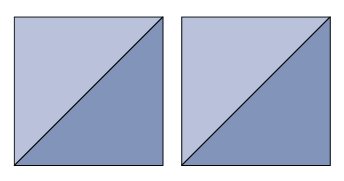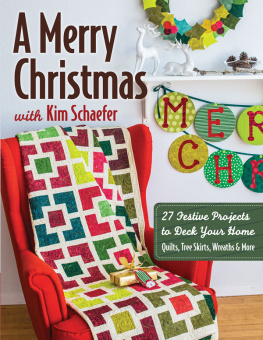PUBLISHER: Amy Marson CREATIVE DIRECTOR: Gailen Runge ACQUISITIONS EDITOR: Roxane Cerda MANAGING EDITOR: Liz Aneloski EDITOR: Kathryn Patterson TECHNICAL EDITOR: Debbie Rodgers COVER/BOOK DESIGNER: April Mostek PRODUCTION COORDINATOR: Zinnia Heinzmann PRODUCTION EDITOR: Jennifer Warren ILLUSTRATOR: Aliza Shalit PHOTO ASSISTANT: Rachel Holmes PHOTOGRAPHY by Kelly Burgoyne of C&T Publishing, Inc. Published by C&T Publishing, Inc., P.O. Box 1456, Lafayette, CA 94549  Dedication To my mother, who always set a beautiful table. We always used cloth napkins at every meal, and she would have a lovely tablecloth on the table every day. Because of her, I have a love of tablescaping.
Dedication To my mother, who always set a beautiful table. We always used cloth napkins at every meal, and she would have a lovely tablecloth on the table every day. Because of her, I have a love of tablescaping.  Tablescaping Setting an Artful Table Every home has a table, whether in a kitchen or separate dining room.
Tablescaping Setting an Artful Table Every home has a table, whether in a kitchen or separate dining room.  Tablescaping Setting an Artful Table Every home has a table, whether in a kitchen or separate dining room.
Tablescaping Setting an Artful Table Every home has a table, whether in a kitchen or separate dining room.
Even in the most remote countries, there is a place for gathering over food, a place for sharing meals. In some areas, I imagine, that place is mainly outside. But for the majority of individuals, couples, and families, the kitchen or dining room table is the heart of the home. I have always loved to set a beautiful table. Its a dream come true to write a book dedicated to making the dining table an art form. Perhaps this is because I never really prided myself on my cooking skills.
Oh, I could cook to get by, but my meals would never win any awards. Dont get me wrongwe all survived in our house. And, just as important, our tables were always impeccably set! Meal times should be relaxing, and having beautiful table surroundings shouldnt cost much. There are always beautiful dishes, table settings, and utensils for sale at secondhand stores. You can also find pitchers, vases, and serving dishes at resale shops, and these can complete any tablescaping theme. If you are not breaking the bank and are able to set a fabulous table, youll feel great.
Plus, your guests will enjoy everything so much more if theyre surrounded by artful settings. This book contains directions for making twenty different table runners as well as several types of place mats and napkins, any of which can be made to match a table runner just by altering the fabric choices. Have fun with it!  An elaborately tablescaped table. It doesnt have to be this dramatic to have a successful gatheringuse your imagination!
An elaborately tablescaped table. It doesnt have to be this dramatic to have a successful gatheringuse your imagination! 
 General Instructions There are a few housekeeping items to cover before we set off on our journey of making some really great projects. Unless otherwise specified, all seam allowances in this book are , yardages are based on fabric that measures 44 wide, and pieces are stitched with right sides together. I like to work using basic squares.
General Instructions There are a few housekeeping items to cover before we set off on our journey of making some really great projects. Unless otherwise specified, all seam allowances in this book are , yardages are based on fabric that measures 44 wide, and pieces are stitched with right sides together. I like to work using basic squares.
Most of my designs involve using squares that are 3, 4, or 5; sometimes I use all three in a pattern by combining them in interesting ways. There are certainly projects in this book that dont use these sizes, but many do. If you dont already have templates in these sizes, I would suggest purchasing some. I like to use fast2cut Simple Square Templates (by C&T Publishing). They come all together in a packet, and oftentimes a 5 template is hard to find!  Making Half-Square Triangles One other design element that you will find repeated in this book is the use of half-square triangles. There are several different ways to make half-square triangles, and I am sure that many people have their favorite ways.
Making Half-Square Triangles One other design element that you will find repeated in this book is the use of half-square triangles. There are several different ways to make half-square triangles, and I am sure that many people have their favorite ways.
The half-square triangles in this book are made as follows. Place 2 squares of fabric right sides together. Usually these are contrasting squares.  Using a rigid ruler and a marking pen or pencil, draw a line from corner to opposite corner.
Using a rigid ruler and a marking pen or pencil, draw a line from corner to opposite corner.  Stitch a seam on both sides of the line.
Stitch a seam on both sides of the line.  Cut along the solid line as drawn.
Cut along the solid line as drawn.
Each pairing of fabrics creates 2 half-square triangle blocks. Open out the half-square triangle blocks and press. Press to the darker of the 2 fabrics. Square the blocks to the size indicated in the pattern.  Using Rickrack Several of the patterns call for rickrack. Rickrack adds a fun and festive look to anything to which it is applied.
Using Rickrack Several of the patterns call for rickrack. Rickrack adds a fun and festive look to anything to which it is applied.
However, there are some tips that are useful when applying it. Adding rickrack to a piece of fabric causes the fabric to shrink up. As the rickrack is sewn onto the piece of fabric, the fabric under it tends to gather ever so slightly. You may not even notice it; however, rickrack shortens the fabric it is being sewn to. Because of this, it is often wise to cut the piece of fabric longer than directed. After the rickrack is sewn to the piece of fabric, measure it again.
Square it to the appropriate size. Rickrack should be sewn to the edge of the fabric with half of the humps above the edge of the fabric and half below. You should see a small edge of fabric above the concave line.  The rickrack should be basted with a longer basting stitch, about below the concave line.
The rickrack should be basted with a longer basting stitch, about below the concave line.  How to Press for Success Quilters young and old will find in the course of their sewing careers that they change their mind about pressing styles. I am currently in a press seam allowances open phase.
How to Press for Success Quilters young and old will find in the course of their sewing careers that they change their mind about pressing styles. I am currently in a press seam allowances open phase.
Prior to this phase, I pressed the seam allowances in the direction that they seemed to want to go. When you have fabrics from different manufacturers or are using fabrics that have different textures in your quilt, the seam allowances will want to lean a particular way. You may end up fighting with them to get them to stay over to one side or another. When you do this, you will find that they will flop back in the direction that they wanted to go anyway; when you sew across them, you will leave a lump or twisted seam allowance. 
Next page












 Dedication To my mother, who always set a beautiful table. We always used cloth napkins at every meal, and she would have a lovely tablecloth on the table every day. Because of her, I have a love of tablescaping.
Dedication To my mother, who always set a beautiful table. We always used cloth napkins at every meal, and she would have a lovely tablecloth on the table every day. Because of her, I have a love of tablescaping.  Tablescaping Setting an Artful Table Every home has a table, whether in a kitchen or separate dining room.
Tablescaping Setting an Artful Table Every home has a table, whether in a kitchen or separate dining room.  An elaborately tablescaped table. It doesnt have to be this dramatic to have a successful gatheringuse your imagination!
An elaborately tablescaped table. It doesnt have to be this dramatic to have a successful gatheringuse your imagination! 
 General Instructions There are a few housekeeping items to cover before we set off on our journey of making some really great projects. Unless otherwise specified, all seam allowances in this book are , yardages are based on fabric that measures 44 wide, and pieces are stitched with right sides together. I like to work using basic squares.
General Instructions There are a few housekeeping items to cover before we set off on our journey of making some really great projects. Unless otherwise specified, all seam allowances in this book are , yardages are based on fabric that measures 44 wide, and pieces are stitched with right sides together. I like to work using basic squares. Making Half-Square Triangles One other design element that you will find repeated in this book is the use of half-square triangles. There are several different ways to make half-square triangles, and I am sure that many people have their favorite ways.
Making Half-Square Triangles One other design element that you will find repeated in this book is the use of half-square triangles. There are several different ways to make half-square triangles, and I am sure that many people have their favorite ways. Using a rigid ruler and a marking pen or pencil, draw a line from corner to opposite corner.
Using a rigid ruler and a marking pen or pencil, draw a line from corner to opposite corner.  Stitch a seam on both sides of the line.
Stitch a seam on both sides of the line.  Cut along the solid line as drawn.
Cut along the solid line as drawn. Using Rickrack Several of the patterns call for rickrack. Rickrack adds a fun and festive look to anything to which it is applied.
Using Rickrack Several of the patterns call for rickrack. Rickrack adds a fun and festive look to anything to which it is applied. The rickrack should be basted with a longer basting stitch, about below the concave line.
The rickrack should be basted with a longer basting stitch, about below the concave line.  How to Press for Success Quilters young and old will find in the course of their sewing careers that they change their mind about pressing styles. I am currently in a press seam allowances open phase.
How to Press for Success Quilters young and old will find in the course of their sewing careers that they change their mind about pressing styles. I am currently in a press seam allowances open phase.